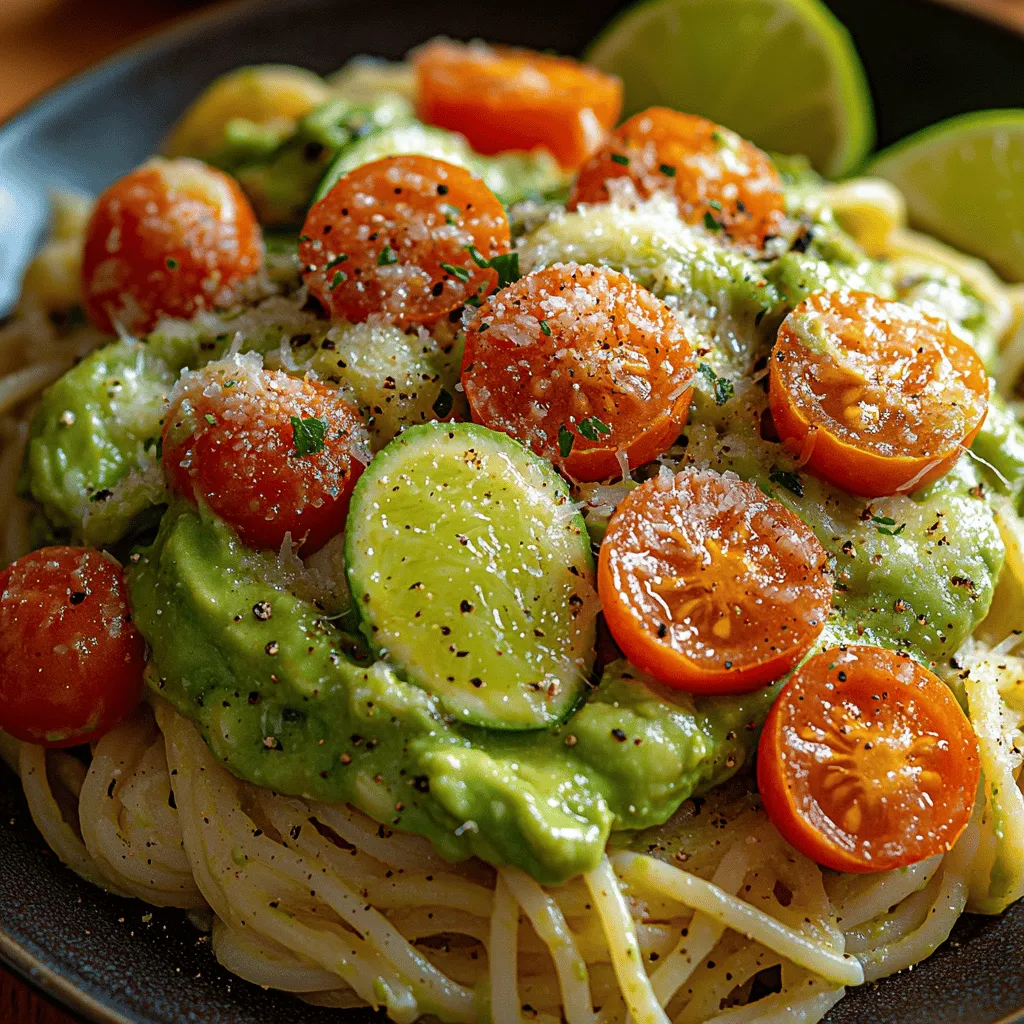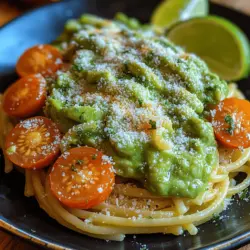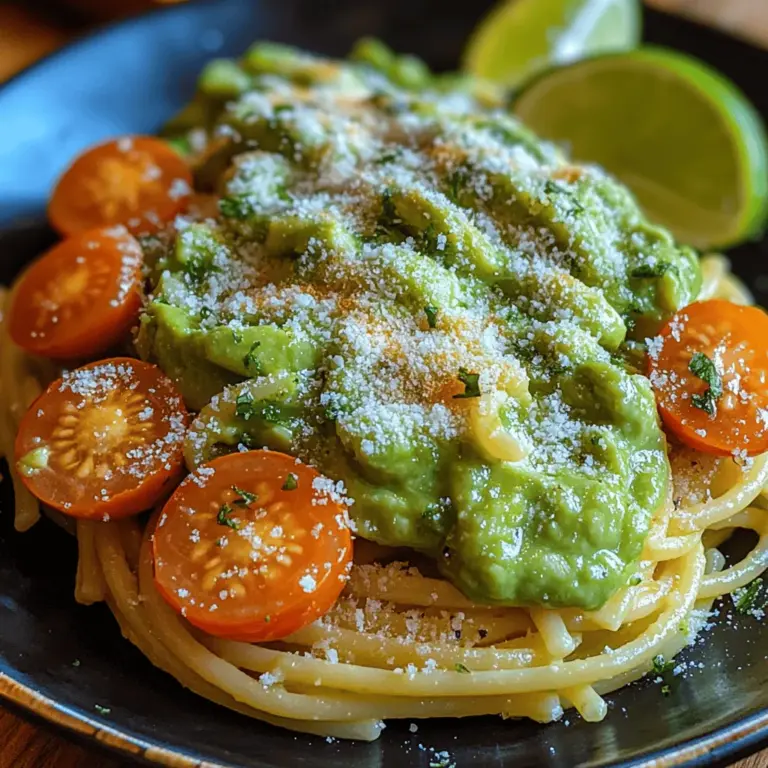Introduction
Pasta is a universal dish loved by many, and when it comes to innovative and health-conscious variations, creamy avocado lime pasta stands out as a delightful option. This dish combines the creaminess of ripe avocados with the zesty brightness of fresh lime, creating a unique culinary experience that is both indulgent and nutritious. It’s an excellent choice for anyone looking to enjoy pasta without the heavy sauces typically associated with traditional recipes, making it a favorite among vegans, vegetarians, and health enthusiasts alike.
The origins of avocado-based recipes can be traced back to various cultures that celebrate the fruit’s rich flavor and creamy texture. Avocado, native to Central and South America, has become a global sensation due to its versatility and health benefits. Rich in healthy fats, fiber, and essential vitamins, avocados are not only delicious but also promote heart health and contribute to a balanced diet. By pairing it with pasta, this recipe offers a light yet satisfying meal that can be prepared in under 30 minutes—perfect for busy weeknights or leisurely weekend lunches.
In this article, we will take you through everything you need to know to make creamy avocado lime pasta, from the ingredients you’ll need to the step-by-step preparation process. Additionally, we’ll share tips and tricks to enhance the flavors of your dish, ensuring it impresses your family and friends. So grab your apron, and let’s dive into this refreshing and creamy pasta dish!
Understanding the Ingredients
Overview of Traditional Pasta Components
Before we jump into the recipe, it’s essential to understand the ingredients that will bring this creamy avocado lime pasta to life. While the star of this dish is undoubtedly the avocado, the other components play a vital role in creating a harmonious blend of flavors.
Pasta Varieties
The first step in crafting a delicious avocado lime pasta is selecting the right type of pasta. While traditional recipes may call for spaghetti or fettuccine, this dish is versatile enough to accommodate various shapes. Here are a few popular options:
– Spaghetti: A classic choice that pairs well with the creaminess of the avocado sauce.
– Fettuccine: Offers a wider noodle that can hold onto the sauce beautifully.
– Penne: The tubular shape allows the sauce to cling on the inside and outside.
– Zucchini Noodles: For a low-carb alternative, spiralized zucchini can be a fantastic substitute.
The cooking method may vary slightly depending on the pasta you choose, but the core principles remain the same.
Fresh vs. Dried Pasta
When it comes to pasta, you have the option of using fresh or dried varieties. Fresh pasta offers a tender texture and cooks quickly, while dried pasta is more accessible and has a longer shelf life. For this recipe, both options work well, but if you want to elevate your dish, consider making fresh pasta at home.
Gluten-Free Options
For those with gluten sensitivities or dietary restrictions, gluten-free pasta is widely available. Made from ingredients like rice flour, quinoa, or chickpeas, these options mimic the texture of traditional pasta without compromising on taste. Just be sure to follow the cooking instructions on the package for the best results.
The Role of Avocados
The creamy texture and richness of the avocado are what make this dish stand out. When selecting avocados, look for ones that are ripe but still firm to the touch. A perfectly ripe avocado will have a dark green or black skin with a slight give when gently pressed. Avoid avocados that feel overly soft or have dark spots, as these may be overripe.
Fresh Lime Juice
Lime juice adds a zesty brightness that balances the creaminess of the avocado. Freshly squeezed lime juice is always recommended over bottled juice, as it provides a more vibrant flavor. The acidity of lime not only enhances the taste of the dish but also helps to prevent the avocado from browning, keeping your sauce looking fresh and appealing.
Garlic and Olive Oil
Garlic adds depth and aroma to the sauce, while high-quality olive oil contributes richness and healthy fats. Using extra virgin olive oil is ideal, as it has a robust flavor that complements the other ingredients beautifully.
Fresh Herbs
To elevate the flavors of your creamy avocado lime pasta, fresh herbs are essential. Cilantro and basil are popular choices that add a fragrant touch. Cilantro brings a fresh, citrusy flavor, while basil offers a sweet, aromatic note. Feel free to experiment with herbs based on your personal preference.
Salt and Pepper
Finally, don’t forget the seasoning! A pinch of salt and freshly cracked black pepper will help bring all the flavors together. Adjust the seasoning to taste, ensuring that each component shines through.
Preparation Steps
Now that we have covered the essential ingredients, let’s move on to the preparation steps for creating your creamy avocado lime pasta. This dish is not only simple to make but also allows for customization based on personal preferences.
Step 1: Cook the Pasta
1. Bring a large pot of salted water to a boil. Use about 1 tablespoon of salt for every 4 quarts of water. This will season the pasta as it cooks.
2. Add the pasta of your choice. Follow the cooking instructions on the package, but aim for al dente, which means the pasta should be cooked but still have a slight bite to it. This typically takes about 8-12 minutes, depending on the type of pasta.
3. Reserve pasta water. Before draining the pasta, be sure to reserve about 1 cup of the starchy pasta cooking water. This can be used later to adjust the creaminess of your sauce.
4. Drain the pasta. After cooking, drain the pasta and set it aside. Do not rinse the pasta, as you want to retain the starch that will help the sauce adhere.
Step 2: Prepare the Avocado Sauce
1. Gather your ingredients. In a food processor or blender, combine the following:
– 2 ripe avocados, pitted and peeled
– Juice of 1-2 fresh limes (to taste)
– 2 cloves of garlic, minced
– 2 tablespoons of extra virgin olive oil
– Salt and pepper to taste
– A handful of fresh herbs (cilantro or basil)
2. Blend until smooth. Process the ingredients until you achieve a creamy, smooth consistency. You may need to scrape down the sides of the bowl to ensure everything is well blended.
3. Adjust the consistency. If the sauce is too thick, gradually add some reserved pasta water until you reach your desired creaminess. This will create a luscious, velvety sauce that clings perfectly to the pasta.
4. Taste and adjust seasoning. Once blended, taste the sauce and adjust the seasoning as necessary, adding more lime juice, salt, or pepper to suit your palate.
Step 3: Combine Pasta and Sauce
1. Toss the pasta with the avocado sauce. In a large mixing bowl, add the drained pasta and pour the creamy avocado sauce over it. Gently toss to combine, ensuring the pasta is coated evenly.
2. Serve immediately. Creamy avocado lime pasta is best enjoyed fresh, as the avocado may oxidize and change color over time. Serve it warm, garnished with additional fresh herbs and a sprinkle of lime zest for an extra burst of flavor.
By following these steps, you’ll create a delightful dish that embodies the essence of creamy avocado lime pasta. Its simplicity and freshness make it a perfect meal for any occasion, whether it’s a cozy dinner at home or a gathering with friends. The next part of this article will delve into serving suggestions and tips for making this dish truly unforgettable. Stay tuned for more delicious insights!

Tips for Boiling Lasagna Sheets to Perfection
Boiling lasagna sheets might seem straightforward, but there are several tips to ensure you achieve the perfect texture and prevent the sheets from sticking together. Start by using a large pot filled with water; this allows the lasagna sheets enough space to move around freely. Add a generous pinch of salt to the boiling water; this enhances the flavor of the pasta.
Once the water reaches a rolling boil, carefully add the lasagna sheets. Stir gently immediately after adding them to prevent sticking. Cooking times can vary depending on the brand, so be sure to check the package for specific instructions. Typically, lasagna sheets will take about 8-10 minutes to cook until al dente.
To ensure you don’t overcook them, taste a sheet a minute or two before the suggested time is up. Once cooked, drain the sheets in a colander and rinse them briefly under cold water to stop the cooking process. You can also lay them flat on a lightly greased baking sheet to prevent them from sticking together while you prepare the rest of your lasagna.
Alternatives to Boiling: No-Boil Noodles and Their Benefits
For those looking to save time or simplify the lasagna-making process, no-boil noodles are a fantastic alternative. These noodles are specially made to bake without pre-cooking, allowing them to absorb moisture from the sauce as the lasagna bakes.
Using no-boil noodles saves precious time and prevents the hassle of handling hot pasta sheets. They also maintain a firmer texture, which some people prefer. However, it’s essential to ensure that your sauce is sufficiently moist; otherwise, the noodles may not cook through properly. If you choose this route, consider adding extra sauce or layering vegetables to maintain the right moisture level.
Assembling the Lasagna
Now that your lasagna sheets are ready, it’s time to assemble the dish. Start by spreading a thin layer of sauce on the bottom of your baking dish. This prevents the noodles from sticking and adds flavor.
Next, lay your first layer of lasagna sheets. Ensure they slightly overlap, creating a solid base. Spread a generous layer of ricotta cheese mixture on top, followed by a layer of marinara sauce. Sprinkle grated mozzarella and a dash of Parmesan cheese for added flavor. Repeat this layering process until you run out of ingredients, typically three to four layers is ideal.
Layering Techniques for Optimal Flavor and Texture
To achieve the best flavor and texture in your lasagna, pay attention to your layering techniques. Begin with a layer of sauce, followed by noodles, then cheese, and repeat. This method ensures that each layer is well-balanced and flavorful.
When spreading the cheese mixture, use an offset spatula for even distribution. For the top layer, finish with a generous portion of mozzarella cheese to create a bubbly, golden crust. To elevate the taste, sprinkle fresh herbs like basil or oregano on each layer.
Importance of Cheese Placement and Sauce Distribution
The placement of cheese and the distribution of sauce in your lasagna impact its overall flavor and texture. The cheese should be layered so that it melts and binds the noodles and sauce together, while the sauce should be spread evenly to prevent dry patches.
For the final layer, make sure to generously cover the noodles with sauce before adding your cheese topping. This ensures that the top layer remains moist while baking and prevents the noodles from becoming hard.
Guidelines for Portion Sizes and Layers
When it comes to portion sizes, consider the appetite of your guests. A standard serving size for lasagna is about one-eighth of the entire dish. If you’re serving a crowd, consider making two smaller lasagnas instead of one large dish. This way, you can adjust portion sizes as needed.
In terms of layers, three to four layers is typical for a lasagna, but you can adjust this based on the depth of your baking dish. Ensure that each layer is balanced; too much of one ingredient can lead to an uneven texture and flavor.
Baking the Lasagna
Preheating the Oven and Choosing the Right Temperature
Before you bake your lasagna, preheat your oven to 375°F (190°C). This temperature is ideal for ensuring that your lasagna cooks evenly and the cheese melts beautifully. A well-preheated oven also helps the lasagna develop a delicious crust on top.
Covering vs. Uncovering: When to Use Aluminum Foil
Covering your lasagna with aluminum foil during the first half of the baking process is crucial. This helps to retain moisture and prevents the top from becoming too brown too quickly. After about 30 minutes of baking, remove the foil to allow the top to brown and become crispy.
Baking Times for Different Types of Lasagna
The baking time for lasagna can vary based on the specific ingredients and whether you’re using no-boil or boiled noodles. Typically, lasagna bakes for about 45 minutes to an hour. If you’re using no-boil noodles, it may take closer to an hour, as they need time to absorb moisture.
To ensure your lasagna is perfectly cooked, look for bubbling sauce around the edges and a golden-brown crust on top.
How to Tell When the Lasagna Is Done Cooking
You can easily check if your lasagna is done by inserting a knife into the center. If it comes out hot and the cheese is bubbly and golden, your lasagna is ready. Additionally, let the lasagna rest for at least 15-20 minutes before slicing. This resting time allows the layers to set, making it easier to cut and serve.
Serving the Lasagna
Best Accompaniments for Lasagna
Lasagna pairs beautifully with various accompaniments. A classic garlic bread is always a hit, offering a crunchy contrast to the soft layers of pasta. A fresh salad with a light vinaigrette can also complement the richness of the lasagna, adding a refreshing touch to your meal.
Garlic Bread and Salads
To elevate your meal, consider serving homemade garlic bread. Simply spread butter mixed with minced garlic and parsley on slices of baguette, toast them in the oven, and serve warm. A simple salad of mixed greens, cherry tomatoes, and shaved Parmesan can provide a delightful balance to the hearty lasagna.
Suggestions for Wine Pairings
When it comes to wine pairings, a medium-bodied red wine like Chianti or Sangiovese complements the rich flavors of lasagna beautifully. If you prefer white wine, a crisp Pinot Grigio works well, especially with lighter lasagna variations.
Presentation Ideas for Serving Lasagna
For a stunning presentation, serve your lasagna in the baking dish it was cooked in or transfer it to a large serving platter. Garnish with fresh basil leaves or a sprinkle of parsley for a pop of color. Cutting the lasagna into neat squares can showcase its beautiful layers, making it an inviting centerpiece for your table.
Ideal Serving Sizes and Plating Techniques
As mentioned earlier, a standard serving size is about one-eighth of the dish. For plating, use a large spatula to carefully lift each piece, ensuring that the layers remain intact. Serve with a side of salad and a piece of garlic bread on the plate for a complete meal.
Storing Leftovers for Maximum Freshness
If you have leftover lasagna, storing it properly is essential for maintaining its flavor and texture. Allow the lasagna to cool completely before covering it tightly with plastic wrap or aluminum foil. You can also transfer leftovers to an airtight container for added freshness.
Leftover lasagna can be stored in the refrigerator for up to five days. If you’d like to keep it longer, consider freezing portions. Wrapped tightly, lasagna can last in the freezer for up to three months.
Tips for Reheating and Freezing Lasagna
To reheat refrigerated lasagna, preheat your oven to 350°F (175°C). Cover the dish with aluminum foil to prevent the top from burning and bake for about 20-30 minutes, or until heated through. If you’re reheating individual portions, the microwave is a quicker option; just be sure to cover the dish to avoid drying out the pasta.
For frozen lasagna, it’s best to thaw it overnight in the refrigerator before reheating. However, you can also bake it directly from frozen, just be aware that it may take longer to cook through.
Variations of Classic Lasagna
Exploring Regional Variations of Lasagna Across Italy
Lasagna is a beloved dish with numerous regional variations across Italy. For instance, Lasagna alla Bolognese, originating from Bologna, is made with a rich meat sauce and béchamel, while Lasagna Napoletana from Naples features layers of ricotta and meatballs, showcasing the diversity of this classic dish.
Lasagna alla Bolognese vs. Lasagna Napoletana
Lasagna alla Bolognese is typically richer due to the use of slow-cooked ragù made with ground meats and a creamy béchamel sauce. In contrast, Lasagna Napoletana is lighter and often incorporates fresh mozzarella and a tomato sauce, emphasizing the quality of the ingredients.
Vegetarian and Vegan Adaptations
For those who prefer a meatless option, vegetarian lasagna is a fantastic alternative. You can use layers of sautéed vegetables such as spinach, zucchini, and mushrooms combined with ricotta and marinara sauce. Additionally, vegan adaptations can replace dairy products with cashew cream or tofu ricotta and use plant-based meat alternatives.
Substituting Ingredients for Plant-Based Diets
If you’re aiming for a plant-based diet, consider substituting traditional ingredients with alternatives such as lentils or chickpeas for protein, and use dairy-free cheese and sauces to maintain the lasagna’s creamy texture.
Creative Twists on the Classic Recipe
To add a unique twist to your lasagna, experiment with seasonal vegetables or alternate meats. For instance, a butternut squash lasagna can provide a sweet and savory flavor, while using ground turkey or chicken can create a lighter variant.
Conclusion
Homemade lasagna is not just a dish; it’s a labor of love that brings family and friends together. The process of layering the ingredients, baking, and finally serving it at the table creates a memorable dining experience.
Whether you choose to stick with the classic recipe or explore regional variations and creative twists, the joy of making lasagna lies in its versatility and the warmth it brings to any gathering. So, gather your loved ones, share your homemade lasagna, and indulge in the comforting flavors that have made this dish a timeless favorite. Happy cooking!

